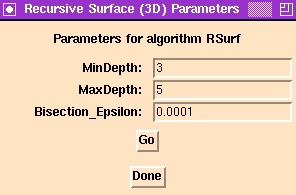Recursive Surface Algorithm (RSurf)
Overview
This algorithm approximates the zero level set of a function of three
variables. That is, given a function from R^3->R, this algorithm
computes the level set of zero associated to that function.
How Recursive Surface Works
The algorithm is implemented recursively.
The basic step of RSurf is to subdivide a cube into eight smaller cubes.
The initial cube is the bounding domain. The algorithm starts by replacing
the initial cube and all that result until all the cubes have some minimum
required depth. (A cube's depth is the depth it has in the octree that
results from the cube replacement.) The algorithm continues by subdividing
when both of the following two conditions are satisfied:
- a cube has not reached the maximum allowed depth and,
- the eight numbers
that result from evaluating the function at the vertices of the cube do
not have the same sign.
Once a cube has reached its maximum depth, a polygonal approximation to the
surface is made by:
- Finding an edge with a sign crossing. That is, the function
is positive on one endpoints of the edge, and is negative at the
other endpoint.
- Tracing from that edge in order to determine which
other cube edges are positive (both endpoints positive),
negative (both endpoints negative) or must be split by the surface.
The polygon is then made from the edges which are intersected by the surface.

The panel that controls the recursive surface algorithm.
Controlling the algorithm from Pisces
The Pisces panel to the RSurf algorithm has 3 parameters:
- MinDepth
- All cubes are divided until they have at least minimum depth.
Example: If MinDepth is 3, then the original cube
(the bounding
domain) is divided into 8 cubes, each of the 8 into 8 cubes, and
each of the resulting 64 into 8 cubes resulting in 512 cubes
filling the original bounding domain.
Default Value: 3
- MaxDepth
- No cubes are allowed to have depth greater than the maximum
depth.
Example: If the MaxDepth is 5, then if
a cube has depth 5 it
will not be subdivided any further, but rather a polygonal approximation
to the surface will result instead.
Default Value: 5
- Bisection_Epsilon
- When bisecting the edge of a cube to find out where
the surface crosses the edge, the bisection process stops on an
interval of
Bisection_Epsilon.
Default Value: 0.0001
Known Bugs
Sometimes a memory allocation error in RSurf will
cause Pisces to crash. If you can systematically reproduce this
crash, we would like that information so that we can fix the problem.
Please send bug reports to
software@geom.umn.edu.
Acknowledgements
The algorithm was implemented by
Daniel B. Krech .
The algorithm was inspired after working on implementing a brute force
method for finding curves in the plane. The method involved dividing each
"scan line" up into n segments,
doing bisection on any segment where the
functions sign changed and drawing the pixel that results from the
bisection. This "scanning algorithm" was suggested by Auden Holme.
Next: Two-Parameter Continuation
Previous: User Interface
![[Pisces]](../../../pix/pi.gif) The Pisces Home Page
The Pisces Home Page
Comments to: pisces@geom.umn.edu
Last modified: Wed Jun 5 08:31:05 1996
Copyright © 1995 by
The Geometry Center,
all rights reserved.

![[Pisces]](../../../pix/pi.gif) The Pisces Home Page
The Pisces Home Page